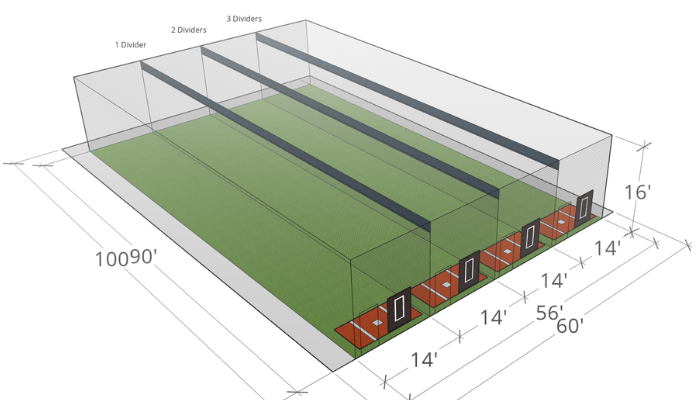Divider Nets: How Many Divider Nets Can Go In Your Facility?
Published January 23, 2024
To maximize space and utility, batting cage facilities commonly employ the use of retractable divider nets to convert tunnels into open spaces.
A facility can accommodate multiple tunnels for hitting practice and, in a matter of minutes, transform into a larger area for fielding and long-toss. Single panel divider nets, detached from the outer “shell” net, slide back and forth, or retract, much like a shower curtain.
So how many tunnels, or divider nets, can you put in your facility?
Let’s start with your building measurements. A common warehouse size might be a 60’ x 100’, wall to wall. Keep in mind that you’ll need the net to come off the wall about two feet to prevent the balls from reaching the wall. In some facilities, you may have to account for emergency exits and allow a few more feet of access outside the net and along the wall.
With this in mind, our shell net, which is the two side panels, two end panels, and a ceiling panel sewn together, may actually need to be 56’ x 90’. Ideally tunnels should be between 12’ and 15’ wide. Batting mats are 12’ wide for a reason, as it gives both left and right handers enough room to comfortably stand in the batter’s box. If your tunnels are smaller, your batting mats will lap over each other and backswings may not clear the net. 10’ tunnels can be OK for younger, smaller players.
What direction should the divider nets run, inside the shell? If you want to replicate full-length pitching, you’ll have to run the divider nets long-ways, in our example 90 feet, to accommodate the 70 feet you’ll need. With 14 foot wide cages, you can fit 4 cages, 90 feet long, with THREE, 90 foot dividers nets. See Example 1 Below.

Example 1
If you only need shorter, soft-toss or T-work hitting areas, then you could go the other way, and run FIVE dividers the short way, creating SIX, 15 x 56 foot long cages. (90’ / 15’ = 6). See Example 2 Below.

Example 2
Does one way cost more than the other? Not by much. Say your ceiling height is 17’, then your nets and dividers might be 16’. 3, 16’ X 90’ divider nets is 4,320 sq ft of net, while 5, 16’ x 56’ divider nets is 4,480 sq ft. In this example, it’s only a 160 sq ft difference.
What about Pitching Tunnels?
We are often asked to design for pitching tunnels, or use some leftover lane, like 8’ x 70’. Which is not a bad idea, however you don’t really need a netted area for pitching practice like you do for hitting and fielding. If you are adamant about it, we’ll do it, but you might be better off just using the space by making all the other tunnels slightly wider.
To summarize, measure the dimensions of your area, subtract for enough space and access outside from your width and length. Then divide the lengths and widths by 12, 13, 14 or 15’ and see how many tunnels you can fit. The number of dividers will just be one less than the number of batting cage tunnels. 6 tunnels = 5 dividers, 5 tunnels = 4 dividers, 4 tunnels = 3 dividers, and so forth.


Very Helpful. We were just having this conversation.
Comment *necesito uno para 3 Cage de bateo